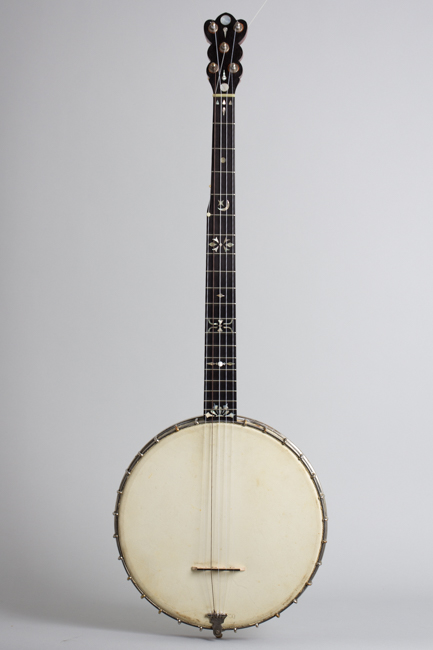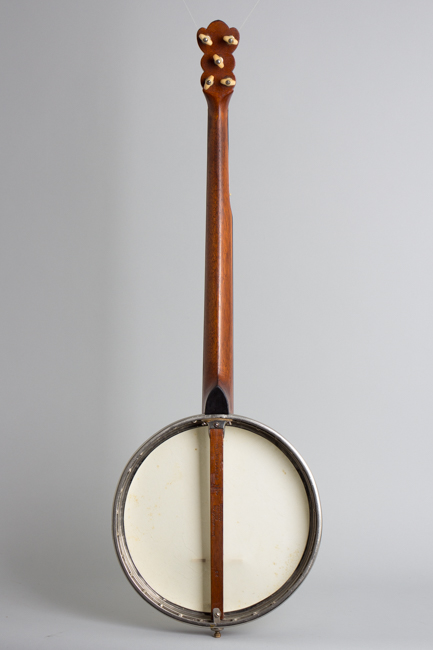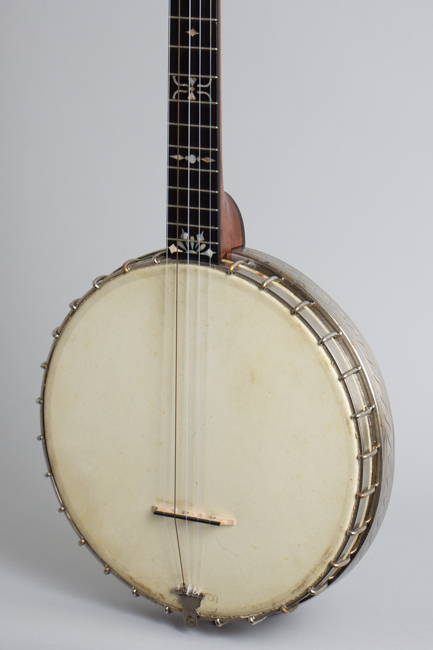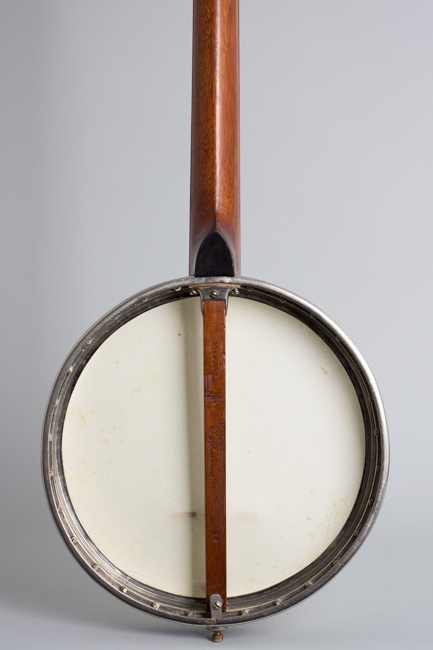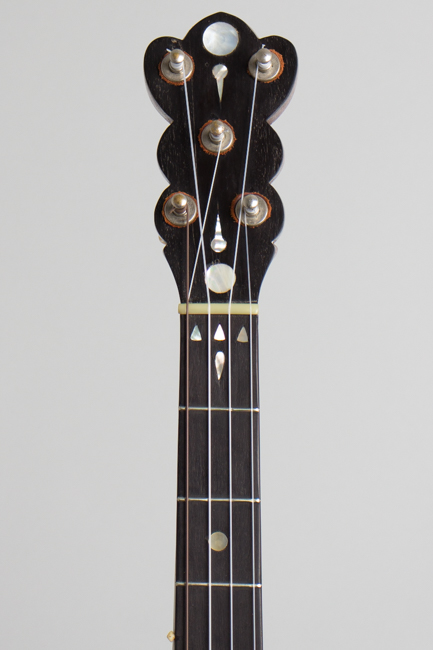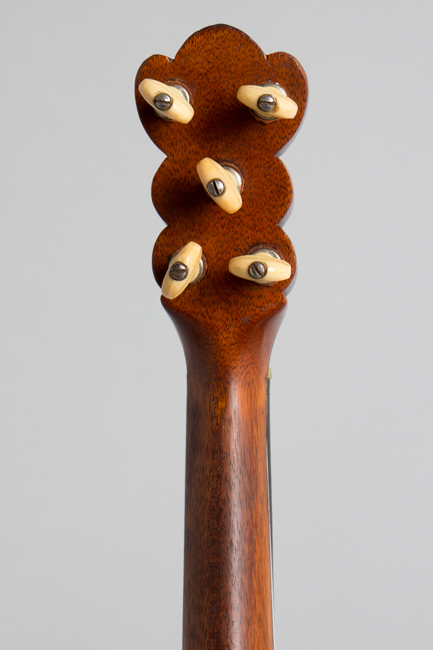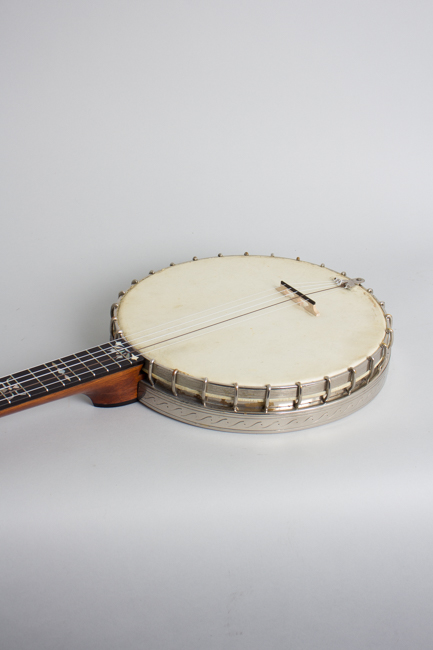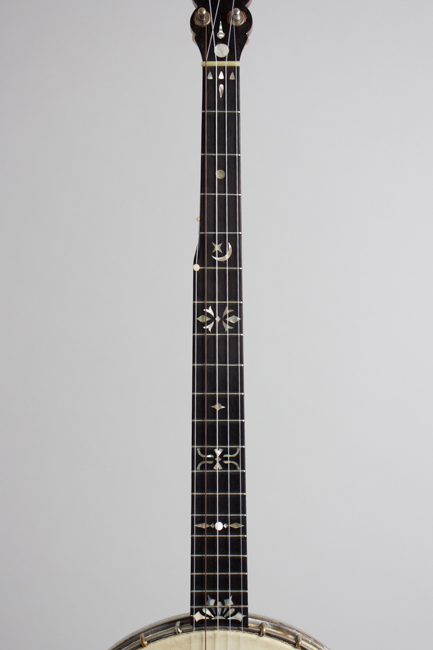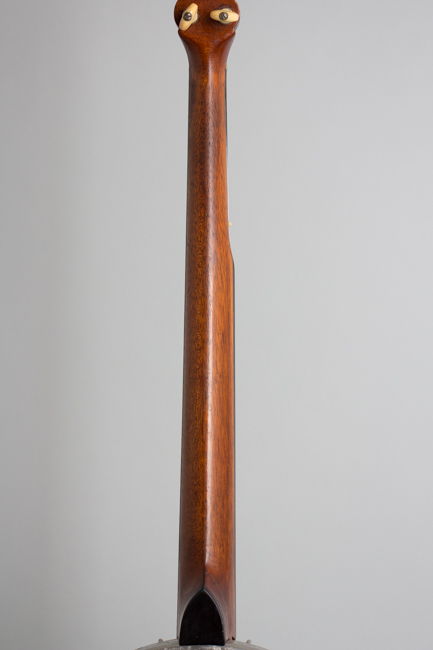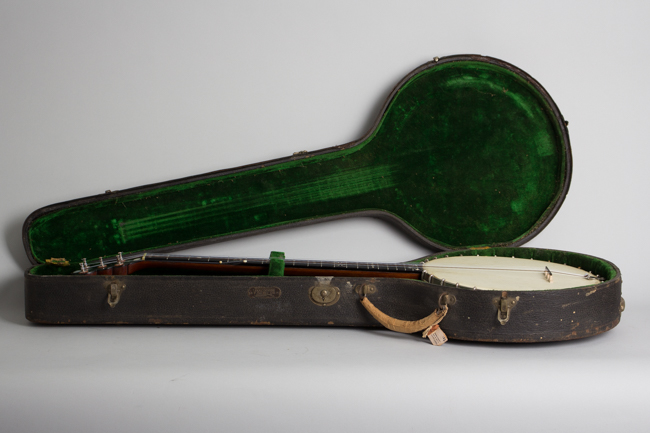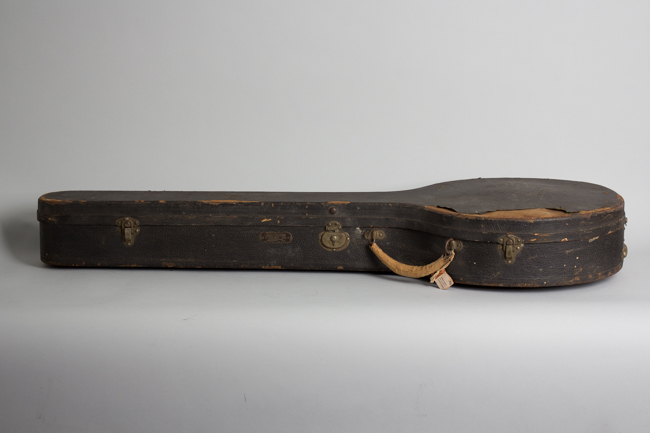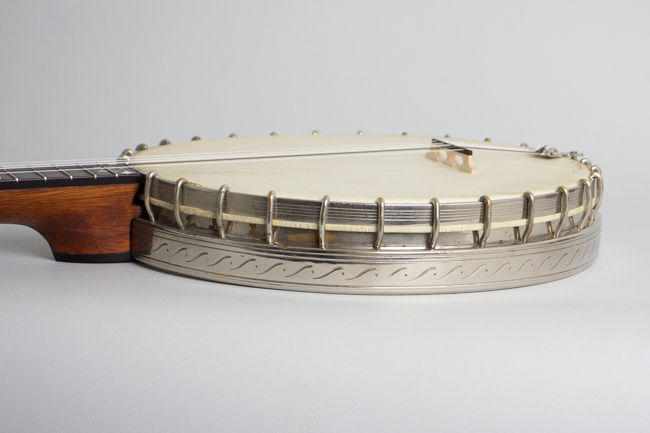Libby Brothers 5 String Banjo (1895)
This item has been sold.
Item # 11667
Prices subject to change without notice.
Libby Brothers 5 String Banjo (1895), made in Gorham, Maine, serial # 66, nickel plating and natural varnish finish, brass rim, mahogany neck with ebony fingerboard, black hard shell case.
This is a very eccentric, obscure and rather beautiful instrument that even most vintage banjo fans have never seen. William F. Libby of Gorham, Maine filed a patent application for the unique features seen on this banjo in February 1895 and in an unusual example of expedited service was awarded said patent that July. This covered not only the hollow 2-stage brass rim but a most creative handling of the 5th string tuning situation as well. Libby noted: "the bottom of the banjo frame is rendered smooth and prevented from wearing the clothes of the performer...said nuts are wholly contained within the body of the frame and will not chafe the clothes of the operator." The patent also covered the use of a channel in the top edge of the neck carrying the 5th string to the headstock, avoiding the usual projecting tuner on the top of the neck.
Libby must have engaged at least one brother in the production of this instruments, hence the legend "Libby Bros. Makers Gorham ME" stamped on the dowel in two places. The Patent date and serial number 66 are stamped in the dowel as well. Sadly it appears that very few of these actually made it to market, and they hardly ever turn up. It's kind of a shame really, as this is a very well engineered and nicely made instrument. The "shoeless" metal rim is sturdily made but also light and handy, neatly engraved on the outer edge and very well plated; it still shines after 125+ years. The neck is very well built as well, carved from mahogany with a medium "V" profile and topped with a very thick ebony fingerboard inlaid with shaped pearl. This is also a feature of the oddly lumpy looking headstock, fitted with 1888 Patent Champion pegs.
The 5th string runs along a trough in the side of the neck to the central tuner in the headstock; actually quite a functional idea and once gotten used to quite logical. Libby certainly thought his design through; everything works well and the instrument is pretty unique. Both concepts were tried by others in this very fertile banjo era but no one combined the metal rim and alternate tuning layout as neatly as he did. It appears the Brothers did not do much marketing outside of their home turf of Maine, and never competed seriously with the likes of Fairbanks, Cole or Stewart. Still, this banjo rates as a very interesting and lovely piece of 5-string history, a truly original and quite functional design that plays and sounds very nice well over a century on.
Overall length is 35 3/4 in. (90.8 cm.), 11 3/4 in. (29.8 cm.) diameter head, and 2 1/8 in. (5.4 cm.) in depth, measured at side of rim. Scale length is 26 5/8 in. (676 mm.). Width of nut is 1 3/16 in. (30 mm.).
This banjo is in solid shape for being nearly 130 years old; it is largely original and fully playable despite its eccentric design. The rim plating is generally well preserved with scuffing, scraping and some loss to the side above the neck. The thin varnish finish is partially worn away on the back of the neck. The unique eccentric hooks and nuts are a complete set, including the original metal tailpiece. Some of the hardware securing the dowel is not original but everything is fully functional.
The neck shows an old repair at the heel, partially through from the bass side. This is solidly sealed but visible. The rest of the neck appears original and in good condition, quite straight with the original frets (showing some wear in the first position from steel strings) and friction tuners. The rim was fitted long ago with an old Amrawco skin head, slightly sloppily trimmed but solid and good sounding. Set up with NylGut strings his banjo plays very well and has a very warm and sweet sound for a metal-rim instrument. It resides in a worn but serviceable 1920s HSC. Overall Very Good + Condition.
This is a very eccentric, obscure and rather beautiful instrument that even most vintage banjo fans have never seen. William F. Libby of Gorham, Maine filed a patent application for the unique features seen on this banjo in February 1895 and in an unusual example of expedited service was awarded said patent that July. This covered not only the hollow 2-stage brass rim but a most creative handling of the 5th string tuning situation as well. Libby noted: "the bottom of the banjo frame is rendered smooth and prevented from wearing the clothes of the performer...said nuts are wholly contained within the body of the frame and will not chafe the clothes of the operator." The patent also covered the use of a channel in the top edge of the neck carrying the 5th string to the headstock, avoiding the usual projecting tuner on the top of the neck.
Libby must have engaged at least one brother in the production of this instruments, hence the legend "Libby Bros. Makers Gorham ME" stamped on the dowel in two places. The Patent date and serial number 66 are stamped in the dowel as well. Sadly it appears that very few of these actually made it to market, and they hardly ever turn up. It's kind of a shame really, as this is a very well engineered and nicely made instrument. The "shoeless" metal rim is sturdily made but also light and handy, neatly engraved on the outer edge and very well plated; it still shines after 125+ years. The neck is very well built as well, carved from mahogany with a medium "V" profile and topped with a very thick ebony fingerboard inlaid with shaped pearl. This is also a feature of the oddly lumpy looking headstock, fitted with 1888 Patent Champion pegs.
The 5th string runs along a trough in the side of the neck to the central tuner in the headstock; actually quite a functional idea and once gotten used to quite logical. Libby certainly thought his design through; everything works well and the instrument is pretty unique. Both concepts were tried by others in this very fertile banjo era but no one combined the metal rim and alternate tuning layout as neatly as he did. It appears the Brothers did not do much marketing outside of their home turf of Maine, and never competed seriously with the likes of Fairbanks, Cole or Stewart. Still, this banjo rates as a very interesting and lovely piece of 5-string history, a truly original and quite functional design that plays and sounds very nice well over a century on.
Overall length is 35 3/4 in. (90.8 cm.), 11 3/4 in. (29.8 cm.) diameter head, and 2 1/8 in. (5.4 cm.) in depth, measured at side of rim. Scale length is 26 5/8 in. (676 mm.). Width of nut is 1 3/16 in. (30 mm.).
This banjo is in solid shape for being nearly 130 years old; it is largely original and fully playable despite its eccentric design. The rim plating is generally well preserved with scuffing, scraping and some loss to the side above the neck. The thin varnish finish is partially worn away on the back of the neck. The unique eccentric hooks and nuts are a complete set, including the original metal tailpiece. Some of the hardware securing the dowel is not original but everything is fully functional.
The neck shows an old repair at the heel, partially through from the bass side. This is solidly sealed but visible. The rest of the neck appears original and in good condition, quite straight with the original frets (showing some wear in the first position from steel strings) and friction tuners. The rim was fitted long ago with an old Amrawco skin head, slightly sloppily trimmed but solid and good sounding. Set up with NylGut strings his banjo plays very well and has a very warm and sweet sound for a metal-rim instrument. It resides in a worn but serviceable 1920s HSC. Overall Very Good + Condition.
